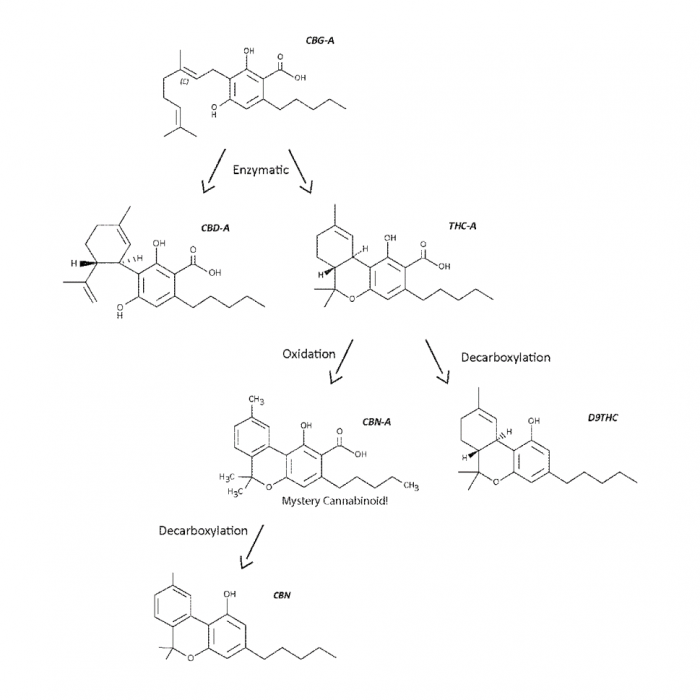Testing for Truth Part 6: The Mystery of the Unknown Cannabinoid
By Dylan Wilks, CTO
In Testing for Truth Part 5, we tested some old cannabis samples that were at least 10 years old. The results were a little unexpected. In brief, we expected to see lots of Cannabinol (CBN) and lots of Delta 9-THC. The typical degradation story for cannabis is that the plant makes Tetrahydrocannabinolic Acid (THCA), then that degrades over time to Delta 9-THC and finally to CBN. While we did see a fair amount of Delta 9-THC, we only saw a small amount of CBN. In addition, we noted an unknown cannabinoid was present. This has vexed us for over a year, but finally we believe we have identified the cannabinoid.
Before we dig into this mystery cannabinoid, let’s start by taking a walk down the rosy path of cannabis degradation. This may get a little far into the weeds, but as we all know cannabis is a complex plant. After all, that’s part of the reason why we all have interest in understanding it. Let’s put on our nerd glasses and lab coats and start near the beginning. Follow the figures below to track our cannabinoid pathways.
The primary cannabinoid made by both hemp and adult use cultivars is cannabigerolic acid (CBGA). I’m ignoring more rare cannabinoids such as the varin types (THCV/CBDV) and skipping over some of the precursors to keep things a little simpler for now. After CBGA is created by the plant, an enzymatic process converts CBGA to THCA or CBDA, though we are focusing on the THCA rich strains in this article. “Enzymatic Process” sounds scary, but it’s just a bunch of “helper” proteins that the plant makes to shuffle around molecules. The end result, in CBGA’s case, is a different cannabinoid, THCA. Hemp varietals have a genetic propensity to create different enzymes, and these different helper proteins create CBDA instead of THCA.
Once the plant is ready to harvest, most of the CBGA has been converted to THCA with little or no Delta 9-THC present. At this stage, we can get into the fun stuff: degradation. I’m going to focus on two different types of degradation: decarboxylation and oxidation. Don’t worry, if you keep reading there’s cake involved…
Decarboxylation converts THCA to Delta 9-THC, and it really has only one ingredient – heat. When THCA is exposed to heat, it can spontaneously convert from THCA to Delta 9-THC. The process releases a CO2 molecule from the THCA molecule. Note that this process can happen at room temperature, but the speed of the reaction goes up logarithmically (meaning more heat= way more decarboxylation). Note as well that the presence of light or air does not come into the equation.
To summarize decarboxylation:
Now on to oxidation. This is where things get interesting, and where the traditional knowledge related to cannabis degradation gets things wrong. The basic process of oxidation involves “giving away” electrons. Think of it as a person that has extra cake at a birthday party. If someone else comes by that doesn’t have any cake, the first person will give away some of their cake to the cake-less person (if they aren’t a jerk). THCA in this case has a bit of extra cake. When an oxygen atom comes by, THCA likes to give away some of its electrons. In doing so, the oxygen carries away not only the electrons but a couple of hydrogens from THCA as well. Two hydrogens and one oxygen combine into H2O, and we just made water from THCA and oxygen. Is anyone thirsty for come cannabis-derived water? With this loss of hydrogen atoms (4 total, but we won’t get into that just now), THCA is no longer THCA. It is now an entirely different animal: (drum roll…) Cannabinolic Acid, or CBNA. This is the mystery cannabinoid we were seeing in the old cannabis! Oxidation requires oxygen (i.e. air) but can be helped along with both heat and light exposure.
To summarize oxidation:
Now we can see there are really two things that can happen to THCA:
In cannabis left for a long time, a mix of both happens, hence the fair amount of Delta 9-THC and “mystery cannabinoid” CBNA. If you smoke cannabis, the huge amount of heat will rapidly increase the decarboxylation, while only helping oxidation a small amount, so you will get mostly Delta 9-THC.
For those of you who listened to the advice to go get cake, you may still have high enough blood sugar levels to ask a couple of questions:
- How is CBN created?
- CBN is created by CBNA through decarboxylation. This is the same way THCA converts to delta 9-THC! This is why we have so little CBN in an old cannabis sample – to get CBN you have to jump through two hoops (oxidation then decarboxylation), not just one.
- Does Delta 9-THC oxidize?
- The short answer is that Delta 9-THC is the jerk at the party that doesn’t like to give away cake. The chemical structure of Delta-9 THC is such that it doesn’t easily interact with oxygen. It could happen, but in practice it rarely does.
So, there you have it, CBNA is something that’s probably present at least in some level in nearly all the cannabis you’ve consumed, and there’s likely a few percent in that bag you found in the back of your sock drawer. If you were to smoke it, you would be consuming more CBN. Research suggests that CBN is a sedative, so you’ll likely feel a bit sleepy after smoking it. Plus, all the cake and chemistry you’ve just consumed might add to that effect…

